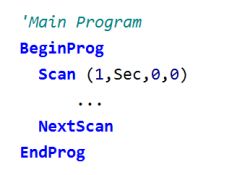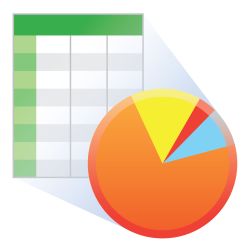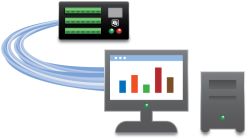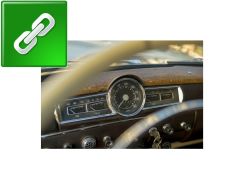This product is not available for new orders. We recommend ordering: CR1000X.
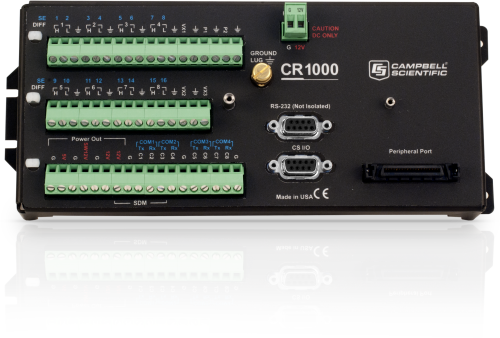
| Services Available | |
|---|---|
| Repair | Yes |
| Calibration | Yes |
| Free Support | No |
Overview
The CR1000 is our most widely used data logger. It can be used in a broad range of measurement and control functions. Rugged enough for extreme conditions and reliable enough for remote environments, it is also robust enough for complex configurations. Used in applications all over the world, it will be a powerful core component for your data-acquisition system.
Read MoreBenefits and Features
- Ideal applications include fire weather, mesonet systems, wind profiling, weather stations, air quality, ETo/agriculture, soil moisture, water level/stage, aquaculture, avalanche forecasting, time-domain reflectometry, vehicle testing, SCADA, and water quality
- Serial communications with serial sensors and devices supported via I/O port pairs
- Collects and stores data and controls peripherals as the brain of your system
- Flexible power and communication options make it ideal for remote locations.
- 4-MB memory can be expanded with add-on memory systems.
- Supports PakBus, Modbus, SDI-12, and DNP3 protocols
- Compatible with channel expansion peripherals allowing you to expand your system
- Program with LoggerNet, PC400, or Short Cut to fit your setup
- Communicates via various options: TCP/IP, email, FTP, web server.
- Gas Discharge Tube (GDT) protected inputs
- Battery-backed clock that ensures accurate time is maintained while data logger is disconnected from battery power
- Program and control on site with addition of CR1000KD keyboard and display unit.
- Contains custom ASIC chip that expands pulse count, control port, and serial communications capabilities
Images













CAD Files:
Detailed Description
The CR1000 consists of a measurement and control module and a wiring panel. This data logger uses an external keyboard/display and power supply. Low power consumption allows the CR1000 to operate for extended time periods on a battery recharged with a solar panel—eliminating the need for AC power. The CR1000 suspends execution when primary power drops below 9.6 V, reducing the possibility of inaccurate measurements.
The CR1000's module measures sensors, drives direct communications and telecommunications, reduces data, controls external devices, and stores data and programs in on-board, non-volatile storage. The electronics are RF shielded and glitch protected by the sealed, stainless-steel canister. A battery-backed clock assures accurate timekeeping. The module can simultaneously provide measurement and communication functions. The on-board, BASIC-like programming language supports data processing and analysis routines.
The CR1000WP is a black, anodized aluminum wiring panel that is compatible with all CR1000 modules. The wiring panel includes switchable 12 V, redistributed analog grounds (dispersed among analog channels rather than grouped), unpluggable terminal block for 12 V connections, gas-tube spark gaps, and 12 V supply on pin 8 to power our COM-series phone modems and other peripherals. The control module easily disconnects from the wiring panel allowing field replacement without rewiring the sensors.
Originally, the standard CR1000 had 2 MB of data/program storage, and an optional version, the CR1000-4M, had 4 MB of memory. In September 2007, the standard CR1000 started having 4 MB of memory, making the CR1000-4M obsolete. Data loggers that have a module with a serial number greater than or equal to 11832 will have a 4 MB memory. The 4 MB data loggers will also have a sticker on the canister stating “4M Memory”.
Compatibility
Note: The following shows notable compatibility information. It is not a comprehensive list of all compatible or incompatible products.
Measurement and Control
| Product | Compatible | Note |
|---|---|---|
| SDM-SIO2R |
Software
| Product | Compatible | Note |
|---|---|---|
| LoggerNet | Version 3.0 or higher | |
| PC200W (retired) | ||
| PC400 | Version 1.2 or higher | |
| PCONNECT (retired) | Version 3.1 or higher | |
| PCONNECTCE (retired) | Version 2.0 or higher | |
| RTDAQ | Version 1.0 or higher | |
| Short Cut | ||
| VISUALWEATHER - Retired (retired) | Version 2.0 or higher |
Additional Compatibility Information
Sensors
With several channel types, the CR1000 is compatible with nearly every available sensor, including thermocouples, SDI-12 sensors, and 4 to 20 mA sensors (via a terminal input module, such as the CURS100). A custom ASIC chip expands its pulse count, control port, and serial communications capabilities. The CR1000's I/O ports can be paired as transmit and receive, allowing serial communications with serial sensors and devices.
Measurement & Control Peripherals
The CR1000 is compatible with all of our CDMs (requires an SC-CPI), SDMs, multiplexers, vibrating-wire interfaces, terminal input modules, and relays.
Communications
The CR1000 communicates with a PC via direct connect, Ethernet interfaces, multidrop modems, short-haul modems, phone modems (land line, digital cellular, and voice-synthesized), RF telemetry, and satellite transmitters (Argos, Iridium, and Inmarsat).
Data can be viewed on the CR1000KD Keyboard Display, the CD100 Mountable Display with Keyboard, an iOS or Android device (requires LoggerLink), CD295 DataView II Display, or a user-supplied PDA (PConnect or PConnectCE software required).
Compatible external data storage devices are the CFM100, NL115, and SC115.
Enclosures
The CR1000 and its power supply can be housed in any of our standard enclosures.
Power
Any 12 Vdc source can power the CR1000 datalogger. Power supplies commonly used with the CR1000 are the BPALK, PS150, and PS200. The BPALK provides eight non-rechargeable D-cell alkaline batteries with a 7.5 Ah rating at 20°C.
Both the PS150 and PS200 consist of a sealed rechargeable 7 Ah battery and a charging regulator. Their battery should be connected to a charging source (either a wall charger or solar panel). These two power supplies differ in their charging regulator. The PS150 has a standard regulator and the PS200 has a micro-controller-based smart regulator. The PS200's regulator provides two-step constant voltage charging and temperature compensation that optimize battery charging and increases the battery’s life.
Also available are the BP12 and BP24 battery packs, which provide nominal ratings of 12 and 24 Ah, respectively. These batteries should be connected to a regulated charging source (e.g., a CH100 or CH200 connected to a unregulated solar panel or wall charger).
Software
CRBasic, the CR1000's full programming language, supports simple or complex programming and many onboard data reduction processes.
Specifications
| -NOTE- | Additional specifications are listed in the CR1000 Specifications Sheet. |
| Operating Temperature Range |
|
| Analog Inputs | 16 single-ended or 8 differential (individually configured) |
| Pulse Counters | 2 |
| Voltage Excitation Terminals | 3 (VX1 to VX3) |
| Communications Ports |
|
| Switched 12 Volt | 1 terminal |
| Digital I/O |
|
| Input Limits | ±5 Vdc |
| Analog Voltage Accuracy | ±(0.06% of reading + offset) at 0° to 40°C |
| ADC | 13-bit |
| Power Requirements | 9.6 to 16 Vdc |
| Real-Time Clock Accuracy | ±3 min. per year (Correction via GPS optional.) |
| Internet Protocols | FTP, HTTP, XML, POP3, SMTP, Telnet, NTCIP, NTP |
| Communication Protocols | PakBus, Modbus, DNP3, SDI-12, SDM |
| Warranty | 3 years |
| Battery-backed SRAM for CPU Usage & Final Storage | 4 MB |
| Idle Current Drain, Average | < 1mA (@ 12 Vdc) |
| Active Current Drain, Average |
|
| Dimensions |
|
| Weight | 1.0 kg (2.1 lb) |
Documents
Technical Papers
- Data Streaming
- Benefits of Input Reversal and Excitation Reversal for Voltage Measurements
- Preventing and Attacking Measurement Noise Problems
- Voltage Measurement Accuracy, Self-Calibration, and Ratiometric Measurements
- DNP3 with Campbell Scientific Dataloggers
- BACnet to Modbus Protocol Conversion (App. Note: 1M-C)
- Irrometer 950R1-O/950T Radio Network (App.Note: 3MI-F)
- AlphaGUARD Radon Monitor Interfaced with the CR1000 Datalogger
- Serial Sensors: Interfacing with CSI Dataloggers (App. Note Code: 2MI-V)
- CF Card Information (3SM-F)
- Modbus Troubleshooting Guide
- FTP Troubleshooting
- HTTP Troubleshooting
Case Studies
Compliance
Videos & Tutorials
Downloads
CR1000 OS v.32.07 (4.60 MB) 05-15-2024
Execution of this download installs the CR1000 Operating System and Compiler on your computer. It also updates the CR1000 support files for the CRBasic Editor.
Note: This OS has crossed the 2 Meg CR1000 size limit for remote download. The OS must be downloaded to the 2 Meg CR1000 via direct connect with the Device Configuration Utility. All OS download methods are supported by the 4 Meg CR1000.
Upgrading from versions prior to version 28 of the Operating System will reset the datalogger’s CPU drive. This is due to a change in the format of the file system from FAT16 to FAT32. In order for the datalogger to operate correctly, as part of the upgrade, the CPU drive is formatted to FAT32. Any programs stored and running from the CPU drive will be lost. It is not recommended to update the datalogger’s Operating System over a remote connection where program control regulates the communication equipment (turning it on or off, etc.). In these cases, an on-site visit and a backup using DevConfig’s backup utility is necessary to update the datalogger’s Operating System.
Watch the Video Tutorial: Sending an OS to a Local Datalogger.
In all cases where the datalogger is being updated from an Operating System prior to 28, the use of DevConfig’s backup utility is recommended due to the CPU drive being formatted using the new FAT32 format.
Device Configuration Utility v.2.33 (49.6 MB) 07-07-2025
A software utility used to download operating systems and set up Campbell Scientific hardware. Also will update PakBus Graph and the Network Planner if they have been installed previously by another Campbell Scientific software package.
Supported Operating Systems:
Windows 11 or 10 (Both 32 and 64 bit)
Frequently Asked Questions
Number of FAQs related to CR1000: 184
Expand AllCollapse All
-
No. The RS-232 does not provide 12 Vdc on any pin. The port does use an RS-232 driver chip that is capable of working with many port-powered interfaces.
-
Yes. Create a multidrop network with an MD485 between the CR5000, the CR1000, and the digital modem. See the “Digital Cellular Modem to MD485 Network” appendix item in the MD485 instruction manual.
-
If both data loggers are using the same cellular modem, simultaneous connection and download is not possible. To resolve this, first create a local network, such as by direct connection, RF4xx radios, an MD485, or Ethernet. Then use the cellular modem to access the network.
-
Pass-code lockouts (historically known as security codes) are the oldest method of securing a Campbell Scientific data logger. This method provides a level of security, mainly for PakBus communications. However, someone with physical access to a data logger or telecommunications hardware may be able to overcome the five-digit pass-code lockouts. To further secure PakBus communications, use the PakBus Encryption Key and PakBus/TCP password.
-
The number of data tables that can be user-defined is more than 250.
-
Yes. Each COM port has individual settings and buffers.
-
Without expansion peripherals, the CR1000 can handle five RS-232 devices. With expansion peripherals, it is possible to have 22 RS-232 devices connected.
-
Telemetry peripherals are discussed and compared in the “Data Storage & Retrieval Peripherals” brochure.
-
Yes. The CR1000 could be set up as a SDI-12 sensor using the SDI12SensorSetup() instruction. Alternatively, the CR1000 could be set up to perform serial communications with the CR3000 by connecting a COM1─COM4 port pair and ground from one data logger to a COM1─COM4 port pair and ground on the other data logger. The COM1─COM4 port lines need to cross RX to TX and vice versa.
Case Studies
Tropical volcanic islands are biodiversity hotspots where the Critical Zone (CZ) remains poorly studied. In......read more
Background In 2022, ECR Medio Ambiente assumed the responsibility of overseeing the structural monitoring installation at......read more
Overview The Chauvet-Pont d'Arc and Aven d'Orgnac caves are home to prehistoric treasures of rare artistic......read more
In 2013, a sinkhole appeared next to a historic home in southern Louisiana. Over the......read more
CS110 Electric Field Meter to Recreate the Carnegie Curve of Earth's Fair-Weather Electric Potential Gradient INESC......read more
The Problem The Lakhta Tower is a building that was completed in 2018, designed for both......read more
The Hong Kong-Zhuhai-Macao Bridge (HZMB)—comprising viaduct bridges, cable-stayed bridges, a submerged tunnel, and artificial islands—is......read more
Steve Rodgers is the lab manager at the Aquaculture Research Center of the Institute of......read more
Articles and Press Releases
Blog Articles
-
But It’s a Dry Heat… like a Furnace

06-21-2021 Author: Dirk Baker -
It’s Time to Embrace the Hybrid

12-02-2019 Author: Kevin Rhodes -
How to Monitor Your Campbell Cellular Modem Data Usage: Part 2

01-30-2019 Author: Nathanael Wright -
Campbell Core Technology: Data Logger Analog Measurement Uncertainty

05-17-2018 Author: Kevin Rhodes -
New Product Support: Kipp & Zonen’s RaZON+

01-17-2018 Author: Matt Perry -
Integrated Peripherals: Expansion made easy

11-29-2017 Author: Timothy Jeppsen -
Replacing Your CR1000 Datalogger with a CR1000X: What You Should Know

10-11-2017 Author: Timothy Jeppsen -
A Quick Comparison of the CR1000X, CR1000, and CR6 Dataloggers

08-16-2017 Author: Timothy Jeppsen -
The CR1000X: A New Generation of Data Loggers with Proven Functionality

08-02-2017 Author: Timothy Jeppsen -
Sending Email from Your Data Logger Just Got Easier!

01-25-2017 Author: Dana Worley -
Available Security Measures for Internet-Connected Data Loggers

12-07-2016 Author: Dana Worley -
Using Internet Data to Promote Outdoor Safety

11-04-2015 Author: Barbra Utley
Newsletter Articles
- Celebrate with Us! 01-24-2018
- Case Study: PGA Tour Lightning Warning System 10-28-2016
- Case Study: High-Elevation Weather in Peru 07-21-2016
- Case Study: Geothermal Development in Colombia 02-02-2016
- Case Study: Dam Monitoring in Puerto Rico 02-02-2016
- Case Study: Webcams in New Hampshire Forest 10-15-2015
- Case Study: Cavern Collapse Alarm 07-21-2015
- Case Study: University of Toronto Green Roof Research 07-21-2015
- Case Study: South Africa Solar Prospecting 04-14-2015
- Case Study: Washington AgWeatherNet 04-14-2015
- Powerful New Operating System for CR800, CR1000, CR3000 02-04-2015
- Case Study: Solar-Energy Assessment in Chile 10-20-2014
- Case Study: South Dakota Irrigation Update 07-30-2014
- Case Study: Florida Endangered Species 07-30-2014
- Case Study: Flood Warning in Arkansas 10-15-2013
- Case Study: Preventing Road Damage from Freezing Conditions in South Korea 05-09-2013
- Case Study: Florida Water Diversion Control 10-18-2012
- Case Study: North Carolina “Green” Hotel 10-18-2012
- New Operating System for CR800, CR1000, CR3000 08-17-2012
- Case Study: Researching Glacier Retreat in the Andes 08-17-2012
- Case Study: Station Provides Flood Warning & Road Weather Data 08-17-2012
- Case Study: Water-Supply SCADA System 03-15-2012
- Case Study: Post-Tensioned, Fiber-Reinforced Bridge 11-16-2011
Privacy Policy Update
We've updated our privacy policy. Learn More
Cookie Consent
Update your cookie preferences. Update Cookie Preferences










